Effect of Environmental Conditions and Morphometric Parameters on Surface Water Temperature in Polish Lakes
Abstract
1. Introduction
- (i)
- to determine the directions and value of changes in surface water temperature in Polish lakes;
- (ii)
- to assess similarities and differences in thermal conditions of lakes;
- (iii)
- to identify climatic and non-climatic factors determining water temperature in lakes as well as the rate and direction of their changes.
2. Materials and Methods
2.1. Study Site Description
2.2. Materials
2.3. Statistical Analysis
3. Results
3.1. Lake Water Temperature
3.2. Water Temperature Trends in Lakes
3.3. Conditions of Distribution of Water Temperatures and Trends
4. Discussion and Conclusions
Author Contributions
Conflicts of Interest
References
- Sharan, A.M.; Pathak, M. Global warming and its effect on flow in Ganga River. Asian J. Water Environ. Pollut. 2013, 10, 117–122. [Google Scholar]
- Elizbarashvili, E.S.; Elizbarashvili, M.E.; Kutaladze, N.B.; Elizbarashvili, S.E.; Chelidze, N.Z. Long-term changes in the number and temperature of hot days in Georgia under global warming. Russ. Meteorol. Hydrol. 2017, 42, 665–670. [Google Scholar] [CrossRef]
- Karmalkar, A.V.; Bradley, R.S. Consequences of global warming of 1.5 °C and 2 °C for regional temperature and precipitation changes in the contiguous United States. PLoS ONE 2017, 12, e0168697. [Google Scholar] [CrossRef] [PubMed]
- Miserendino, M.L.; Brand, C.; Epele, L.B.; Di Prinzio, C.Y.; Omad, G.H.; Archangelsky, M.; Martínez, O.; Kutschker, A.M. Biotic diversity of benthic macroinvertebrates at contrasting glacier-fed systems in Patagonia Mountains: The role of environmental heterogeneity facing global warming. Sci. Total Environ. 2018, 622–623, 152–163. [Google Scholar] [CrossRef] [PubMed]
- Xiu, P.; Chai, F.; Curchitser, E.N.; Castruccio, F.S. Future changes in coastal upwelling ecosystems with global warming: The case of the California Current System. Sci. Rep. 2018, 8, 2866. [Google Scholar] [CrossRef] [PubMed]
- Bartosiewicz, M.; Laurion, I.; Clayer, F.; Maranger, R. Heat-wave effects on oxygen, nutrients, and phytoplankton can alter global warming potential of gases emitted from a small shallow lake. Environ. Sci. Technol. 2016, 50, 6267–6275. [Google Scholar] [CrossRef] [PubMed]
- Yang, K.; Yu, Z.; Luo, Y.; Yang, Y.; Zhao, L.; Zhou, X. Spatial and temporal variations in the relationship between lake water surface temperatures and water quality—A case study of Dianchi Lake. Sci. Total Environ. 2018, 624, 859–871. [Google Scholar] [CrossRef] [PubMed]
- Pełechata, A.; Pełechaty, M.; Pukacz, A. Winter temperature and shifts in phytoplankton assemblages in a small Chara-lake. Aquat. Bot. 2015, 124, 10–18. [Google Scholar] [CrossRef]
- Haberman, J.; Haldna, M. How are spring zooplankton and autumn zooplankton influenced by water temperature in a polymictic lake? Proc. Est. Acad. Sci. 2017, 66, 264–278. [Google Scholar] [CrossRef]
- Gronewold, A.D.; Stow, C.A. Water loss from the great lakes. Science 2014, 343, 1084–1085. [Google Scholar] [CrossRef] [PubMed]
- Wan, W.; Li, H.; Xie, H.; Hong, Y.; Long, D.; Zhao, L.; Han, Z.; Cui, Y.; Liu, B.; Wang, C.; et al. A comprehensive data set of lake surface water temperature over the Tibetan Plateau derived from MODIS LST products 2001–2015. Sci. Data 2017, 4, 170095. [Google Scholar] [CrossRef] [PubMed]
- Livingstone, D.M.; Padisak, J. Large-scale coherence in the response of Lake surface-water temperatures to synoptic-scale climate forcing during summer. Limnol. Oceanogr. 2007, 52, 896–902. [Google Scholar] [CrossRef]
- Adrian, R.; O’Reilly, C.M.; Zagarese, H.; Baines, S.B.; Hessen, D.O.; Keller, W.; Livingstone, D.M.; Sommaruga, R.; Straile, D.; Van Donk, E.; et al. Lakes as sentinels of climate change. Limnol. Oceanogr. 2009, 54, 2283–2297. [Google Scholar] [CrossRef] [PubMed]
- O’Reilly, C.M.; Sharma, S.; Gray, D.K.; Hampton, S.E.; Read, J.S.; Rowley, R.J.; Schneider, P.; Lenters, J.D.; McIntyre, P.B.; Kraemer, B.M.; et al. Rapid and highly variable warming of lake surface waters around the globe. Geophys. Res. Lett. 2015, 42, 10773–10781. [Google Scholar] [CrossRef]
- Magee, M.R.; Wu, C.H. Response of water temperatures and stratification to changing climate in three lakes with different morphometry. Hydrol. Earth Syst. Sci. 2017, 21, 6253–6274. [Google Scholar] [CrossRef]
- Winslow, L.A.; Read, J.S.; Hansen, G.J.A.; Hanson, P.C. Small lakes show muted climate change signal in deepwater temperatures. Geophys. Res. Lett. 2015, 42, 355–361. [Google Scholar] [CrossRef]
- Choiński, A.; Ptak, M.; Strzelczak, A. Areal variation in ice cover thickness on Lake Morskie Oko (Tatra Mountains). Carpath. J. Earth Environ. Sci. 2013, 8, 97–102. [Google Scholar]
- Novikmec, M.; Svitok, M.; Kočický, D.; Šporka, F.; Bitušík, P. Surface water temperature and ice cover of Tatra Mountains Lakes depend on altitude, topographic shading and bathymetry. Arct. Antarct. Alp. Res. 2013, 45, 77–87. [Google Scholar] [CrossRef]
- Coats, R.; Perez-Losada, J.; Schladow, G.; Richards, R.; Goldman, C. The warming of Lake Tahoe. Clim. Chang. 2006, 76, 121–148. [Google Scholar] [CrossRef]
- Katsev, S.; Aaberg, A.A.; Crowe, S.A.; Hecky, R.E. Recent warming of Lake Kivu. PLoS ONE 2014, 9, e109084. [Google Scholar] [CrossRef] [PubMed]
- Huang, L.; Wang, J.; Zhu, L.; Ju, J.; Daut, G. The warming of large lakes on the Tibetan plateau: Evidence from a lake model simulation of Nam Co., China, during 1979–2012. J. Geophys. Res. Atmos. 2017, 122. [Google Scholar] [CrossRef]
- Ptak, M.; Wrzesiński, D.; Choiński, A. Long-term changes in the hydrological regime of high mountain lake Morskie Oko (Tatra Mountains, Central Europe). J. Hydrol. Hydromech. 2017, 65, 146–153. [Google Scholar] [CrossRef]
- Tanentzap, A.J.; Yan, N.D.; Keller, B.; Girard, R.; Heneberry, J.; Gunn, J.M.; Hamilton, D.P.; Taylor, P.A. Cooling lakes while the world warms: Effects of forest regrowth and increased dissolved organic matter on the thermal regime of a temperate, urban lake. Limnol. Oceanogr. 2008, 53, 404–410. [Google Scholar]
- Luoto, T.P.; Nevalainen, L. Long-term water temperature reconstructions from mountain lakes with different catchment and morphometric features. Sci. Rep. 2013, 3, 2488. [Google Scholar] [CrossRef] [PubMed]
- Choiński, A. Katalog jezior Polski; Wydawnictwo Naukowe Uniwersytetu im. Adama Mickiewicza: Poznań, Poland, 2006. [Google Scholar]
- Dąbrowski, M.; Marszelewski, W.; Skowron, R. The trends and dependencies between air and water temperatures in the lakes located in Northern Poland in the years 1961–2000. Hydrol. Earth Syst. Sci. 2004, 8, 79–87. [Google Scholar] [CrossRef]
- Sima, S.; Ahmadalipour, A.; Tajrishy, M. Mapping surface temperature in a hyper-saline lake and investigating the effect of temperature distribution on the lake evaporation. Remote Sens. Environ. 2013, 136, 374–385. [Google Scholar] [CrossRef]
- Kowalczak, P.; Farat, R.; Kepińska-Kasprzak, M.; Kuźnicka, M.; Mager, P. Hierarchy of Aerial Smallwater Retention Need; Materiały Badawcze, Seria: Gospodarka Wodna a Ochrona Wód, 19; IMGW: Warszawa, Poland, 1997. [Google Scholar]
- Kowalska, A. Termika jezior północnej Polski. Czas. Geogr. 1972, 43, 371–385. [Google Scholar]
- Skowron, R. Water Temperature of Lakes in North Poland as Index of Climate Change. In Przeobrażenia Stosunków Wodnych w Warunkach Zmieniającego Się Środowiska. Jankowski, A.T., Absalon, D., Machowski, R., Ruman, M., Eds.; Wydział Nauk o Ziemi Uniwersytetu Śląskiego: Sosonowic, 2009; pp. 255–268. [Google Scholar]
- Ptak, M.; Choiński, A.; Piekarczyk, J.; Pryłowski, T. Application of Landsat satellite thermal images in the analysis of the temperature of Polish lakes. Pol. J. Environ. Stud. 2017, 26, 2159–2165. [Google Scholar] [CrossRef]
- Choiński, A.; Ptak, M.; Strzelczak, A. Present-day evolution of coastal lakes based on the example of Jamno and Bukowo (the Southern Baltic coast). Oceanol. Hydrobiol. Stud. 2014, 43, 178–184. [Google Scholar] [CrossRef]
- Becker, M.W.; Daw, A. Influence of lake morphology and clarity on water surface temperature as measured by EOS ASTER. Remote Sens. Environ. 2005, 99, 288–294. [Google Scholar] [CrossRef]
- Torbick, N.; Ziniti, B.; Wu, S.; Linder, E. Spatiotemporal lake skin summer temperature trends in the northeast United States. Earth Interact. 2016, 20, 25. [Google Scholar] [CrossRef]
- Marszelewski, W. Changes of the Biotic Conditions in the Lakes of North-East Poland; Nicolaus Copernicus University Scientific Publisher: Toruń, Poland, 2005; p. 288. [Google Scholar]
- Kendall, M.G.; Stuart, A. The Advanced Theory of Statistics, 3; Charles Griffin (Ltd.): London, UK, 1968. [Google Scholar]
- Gilbert, R.O. Statistical Methods for Environmental Pollution Monitorin; Van Nostrand Reinhold Co.: New York, NY, USA, 1987; p. 320. [Google Scholar]
- Salmi, T.; Määttä, A.; Anttila, P.; Ruoho-Airola, T.; Amnell, T. Detecting Trends of Annual Values of Atmospheric Pollutants by the Mann-Kendall Test and Sen’s Slope Estimates—The Excel Template Application MAKESENS; Publications on Air Quality 31; Finnish Meteorological Institute: Helsinki, Finland, 2002; p. 35. [Google Scholar]
- Obolewski, K.; Glińska-Lewczuk, K.; Strzelczak, A. Does hydrological connectivity determine the benthic macroinvertebrate structure in oxbow lakes? Ecohydrology 2015, 8, 1488–1502. [Google Scholar] [CrossRef]
- Liu, C.W.; Lin, K.H.; Kuo, Y.M. Application of factor analysis in the assessment of groundwater quality in blackfoot disease in Taiwan. Sci. Total Environ. 2003, 313, 77–89. [Google Scholar] [CrossRef]
- Skowron, R. The Differentiation and the Changeability of Chosen Elements of the Thermal Regime of Water in Lakes on Polish Lowland; Nicolaus Copernicus University Scientific Publisher: Toruń, Poland, 2011; p. 346. [Google Scholar]
- Girjatowicz, J.P. The relationships between water level in coastal lakes and sea water of Polish coast of Baltic Sea. Prz. Geofiz. 2008, 53, 141–153. [Google Scholar]
- Wrzesiński, D.; Choiński, A.; Ptak, M. Effect of the North Atlantic Oscillation on the thermal characteristics of lakes in Poland. Acta Geophys. 2015, 63, 863–883. [Google Scholar] [CrossRef]
- Ptak, M.; Nowak, B. Variability of oxygen-thermal conditions in selected lakes in Poland. Ecol. Chem. Eng. S 2016, 23, 639–650. [Google Scholar] [CrossRef]
- Safaie, A.; Litchman, E.; Phanikumar, M.S. Evaluating the role of groundwater on circulation and thermal structure in a deep inland lake. Adv. Water Resour. 2017, 108, 310–327. [Google Scholar] [CrossRef]
- Woś, A. Climate of Poland in the Second Half of the 20th Century; Wydawnictwo Naukowe Uniwersytetu im. Adama Mickiewicza: Poznań, Poland, 2010. [Google Scholar]
- Livingstone, D.M.; Lotter, A.F.; Walker, I.R. The decrease in summer surface water temperature with altitude in Swiss Alpine lakes: A comparison with air temperature lapse rates. Arct. Antarct. Alp. Res. 1999, 31, 341–352. [Google Scholar] [CrossRef]
- Carpenter, S.R.; Stanley, E.H.; Vander Zanden, M.J. State of the world’s freshwater ecosystems: Physical, chemical, and biological changes. Annu. Rev. Environ. Resour. 2011, 36, 75–99. [Google Scholar] [CrossRef]
- Woolway, R.I.; Dokulil, M.T.; Marszelewski, W.; Schmid, M.; Bouffard, D. Warming of Central European lakes and their response to the 1980s climate regime shift. Clim. Chang. 2017, 42, 505–520. [Google Scholar] [CrossRef]
- Kruzel, J.; Ziernicka-Wojtaszek, A. Diversity of air temperature in Poland in the years 1971–2010. J. Ecol. Eng. 2016, 17, 27–231. [Google Scholar] [CrossRef][Green Version]
- Tomczyk, A.M.; Bednorz, E. Heat waves in Central Europe and their circulation conditions. Int. J. Climatol. 2016, 36, 770–782. [Google Scholar] [CrossRef]
- Danis, P.-A.; von Grafenstein, U.; Masson-Delmotte, V.; Planton, S.; Gerdeaux, D.; Moisselin, J.-M. Vulnerability of two European lakes in response to future climatic changes. Geophys. Res. Lett. 2004, 31, 163–183. [Google Scholar] [CrossRef]
- Rao, Y.R.; Huang, A.; Schertzer, W.M.; Rouse, W.R. Modelling of physical processes and assessment of climate change impacts in great bear lake. Atmos. Ocean 2012, 50, 317–333. [Google Scholar] [CrossRef]
- Apsite, E.; Elferts, D.; Zubaničs, A.; Latkovska, I. Long-term changes in hydrological regime of the lakes in Latvia. Hydrol. Res. 2014, 45, 308–321. [Google Scholar] [CrossRef]
- Naumenko, M.A.; Guzivaty, V.V.; Karetnikov, S.G. Climatic trends of the water surface temperature in Lake Ladoga during ice-free periods. Dokl. Earth Sci. 2006, 409, 750–753. [Google Scholar] [CrossRef]
- Jeppesen, E.; Mehner, T.; Winfield, I.J.; Kangur, K.; Sarvala, J.; Gerdeaux, D.; Rask, M.; Malmquist, H.J.; Holmgren, K.; Volta, P.; et al. Impacts of climate warming on the long-term dynamics of key fish species in 24 European lakes. Hydrobiologia 2012, 694, 1–39. [Google Scholar] [CrossRef]
- Mooij, W.M.; De Senerpont Domis, L.N.; Hülsmann, S. The impact of climate warming on water temperature, timing of hatching and young-of-the-year growth of fish in shallow lakes in the Netherlands. J. Sea Res. 2008, 60, 32–43. [Google Scholar] [CrossRef]
- Hampton, S.E.; Izmest'eva, L.R.; Moore, M.V.; Katz, S.L.; Dennis, B.; Silow, E.A. Sixty years of environmental change in the world's largest freshwater Lake–Lake Baikal, Siberia. Glob. Chang. Biol. 2008, 14, 1947–1958. [Google Scholar] [CrossRef]
- Schneider, P.; Hook, S.J. Space observations of inland water bodies show rapid surface warming since 1985. Geophys. Res. Lett. 2010, 37, 208–217. [Google Scholar] [CrossRef]
- Wrzesiński, D.; Choiński, A.; Ptak, M.; Skowron, R. Effect of the North Atlantic Oscillation on the pattern of lake ice phenology in Poland. Acta Geophys. 2015, 63, 1664–1684. [Google Scholar] [CrossRef]
- Choiński, A.; Ptak, M.; Skowron, R.; Strzelczak, A. Changes in ice phenology on Polish lakes from 1961–2010 related to location and morphometry. Limnologica 2015, 53, 42–49. [Google Scholar] [CrossRef]
- Piccolroaz, S.; Toffolon, M.; Majone, B. The role of stratification on lakes’ thermal response: The case of Lake Superior. Water Resour. Res. 2015, 51, 7878–7894. [Google Scholar] [CrossRef]
- Austin, J.A.; Colman, S.M. Lake Superior summer water temperatures are increasing more rapidly than regional temperatures: A positive ice-albedo feedback. Geophys. Res. Lett. 2007, 34, 125–141. [Google Scholar] [CrossRef]
- Mishra, V.; Cherkauer, K.A.; Bowling, L.C. Changing thermal dynamics of lakes in the Great Lakes region: Role of ice cover feedbacks. Glob. Planet. Chang. 2011, 75, 155–172. [Google Scholar] [CrossRef]
- Kintisch, E. Earth’s lakes are warming faster than its air: First ever global survey reveals summer lake temperatures rising at an alarming rate. Science 2015, 350, 1449. [Google Scholar] [CrossRef] [PubMed]
- Findikakis, A.N.; Law, A.W.K. Wind mixing in temperature simulations for lakes and reservoirs. J. Environ. Eng. 1999, 125, 420–428. [Google Scholar] [CrossRef]
- Desai, A.R.; Austin, J.A.; Bennington, V.; McKinley, G.A. Stronger winds over a large lake in response to weakening air-to-lake temperature gradient. Nat. Geosci. 2009, 2, 855–858. [Google Scholar] [CrossRef]
- Kimura, N.; Wu, C.H.; Hoopes, J.A.; Tai, A. Diurnal dynamics in a small shallow lake under spatially nonuniform wind and weak stratification. J. Hydraul. Eng. 2016, 142, 04016047. [Google Scholar] [CrossRef]
- Woolway, R.I.; Meinson, P.; Nõges, P.; Jones, I.D.; Laas, A. Atmospheric stilling leads to prolonged thermal stratification in a large shallow polymictic lake. Clim. Chang. 2017, 141, 759–773. [Google Scholar] [CrossRef]
- Choiński, A. Limnologia fizyczna Polski; Wydawnictwo Naukowe Uniwersytetu im. Adama Mickiewicza: Poznań, Poland, 2007. [Google Scholar]
- Read, J.S.; Rose, K.C. Physical responses of small temperate lakes to variation in dissolved organic carbon concentrations. Limnol. Oceanogr. 2013, 58, 921–931. [Google Scholar] [CrossRef]
- Rose, K.C.; Winslow, L.A.; Read, J.S.; Hansen, G.J.A. Climate-induced warming of lakes can be either amplified or suppressed by trends in water clarity. Limnol. Oceanogr. Lett. 2016, 1, 44–53. [Google Scholar] [CrossRef]
- Xenopoulos, M.A.; Schindler, D.W. The environmental control of near-surface thermoclines in boreal lakes. Ecosystems 2001, 4, 699–707. [Google Scholar] [CrossRef]
- Flaim, G.; Eccel, E.; Zeileis, A.; Toller, G.; Cerasino, L.; Obertegger, U. Effects of re-oligotrophication and climate change on lake thermal structure. Freshw. Biol. 2016, 61, 1802–1814. [Google Scholar] [CrossRef]
- Richardson, D.C.; Melles, S.J.; Pilla, R.M.; Hetherington, A.L.; Knoll, L.B.; Williamson, C.E.; Kraemer, B.M.; Jackson, J.R.; Long, E.C.; Moore, K.; et al. Transparency, geomorphology and mixing regime explain variability in trends in lake temperature and stratification across Northeastern North America (1975–2014). Water 2017, 9, 442. [Google Scholar] [CrossRef]
- Vinnä, L.R.; Wüest, A.; Zappa, M.; Fink, G.; Bouffard, D. Tributaries affect the thermal response of lakes to climate change. Hydrol. Earth Syst. Sci. 2018, 22, 31–51. [Google Scholar] [CrossRef]
- Ptak, M.; Tomczyk, A.M.; Wrzesiński, D. Effect of teleconnection patterns on changes in water temperature in Polish lakes. Atmosphere 2018, 9, 1–17. [Google Scholar]
- Kainz, M.J.; Ptacnik, R.; Rasconi, S.; Hager, H.H. Irregular changes in lake surface water temperature and ice cover in subalpine Lake Lunz, Austria. Inland Waters 2017, 7, 27–33. [Google Scholar] [CrossRef]
- Valerio, G.; Pilotti, M.; Barontini, S.; Leoni, B. Sensitivity of the multiannual thermal dynamics of a deep pre-alpine lake to climatic change. Hydrol. Process. 2015, 29, 767–779. [Google Scholar] [CrossRef]
- Ptak, M.; Choiński, A.; Kirviel, J. Long-term water temperature fluctuations in coastal rivers (Southern Baltic) in Poland. Bull. Geogr. Phys. Geogr. Ser. 2016, 11, 35–42. [Google Scholar] [CrossRef]
- Boehrer, B.; Schultze, M. Stratification of lakes. Rev. Geophys. 2008, 46, RG000210. [Google Scholar] [CrossRef]
- Nõges, P.; Nõges, T.; Ghiani, M.; Paracchini, B.; Pinto Grande, J.; Sena, F. Morphometry and trophic state modify the thermal response of lakes to meteorological forcing. Hydrobiologia 2011, 667, 241–254. [Google Scholar] [CrossRef]
- Goyer, K.; Bertolo, A.; Pépino, M.; Magnan, P. Effects of lake warming on behavioural thermoregulatory tactics in a cold-water stenothermic fish. PLoS ONE 2014, 9, e92514. [Google Scholar] [CrossRef] [PubMed]
- Baranov, V.; Lewandowski, J.; Krause, S. Bioturbation enhances the aerobic respiration of lake sediments in warming lakes. Biol. Lett. 2016, 12, 20160448. [Google Scholar] [CrossRef] [PubMed]
- Izmest'eva, L.R.; Moore, M.V.; Hampton, S.E.; Ferwerda, C.J.; Gray, D.K.; Woo, K.H.; Pislegina, H.V.; Krashchuk, L.S.; Shimaraeva, S.V.; Silow, E.A. Lake-wide physical and biological trends associated with warming in Lake Baikal. J. Gt. Lakes Res. 2016, 42, 6–17. [Google Scholar] [CrossRef]
- Przytulska, A.; Bartosiewicz, M.; Vincent, W.F. Increased risk of cyanobacterial blooms in northern high-latitude lakes through climate warming and phosphorus enrichment. Freshw. Biol. 2017, 62, 1986–1996. [Google Scholar] [CrossRef]
- Hovel, R.A.; Thorson, J.T.; Carter, J.L.; Quinn, T.P. Within-lake habitat heterogeneity mediates community response to warming trends. Ecology 2017, 98, 2333–2342. [Google Scholar] [CrossRef] [PubMed]
- Lepori, F. ; Roberts; J.J. Past and future warming of a deep European lake (Lake Lugano): What are the climatic drivers? J. Gt. Lakes Res. 2015, 41, 973–981. [Google Scholar] [CrossRef]
- Van Zuiden, T.M.; Chen, M.M.; Stefanoff, S.; Lopez, L.; Sharma, S. Projected impacts of climate change on three freshwater fishes and potential novel competitive interactions. Divers. Distrib. 2016, 22, 603–614. [Google Scholar] [CrossRef]
- Bucak, T.; Trolle, D.; Tavşanoğlu, Ü.N.; Çakıroğlu, A.İ.; Özen, A.; Jeppesen, E.; Beklioğlu, M. Modeling the effects of climatic and land use changes on phytoplankton and water quality of the largest Turkish freshwater lake: Lake Beyşehir. Sci. Total Environ. 2018, 621, 802–816. [Google Scholar] [CrossRef] [PubMed]
- Ladwig, R.; Furusato, E.; Kirillin, G.; Hinkelmann, R.; Hupfer, M. Climate change demands adaptive management of urban lakes: Model-based assessment of management scenarios for Lake Tegel (Berlin, Germany). Water 2018, 10, 186. [Google Scholar] [CrossRef]
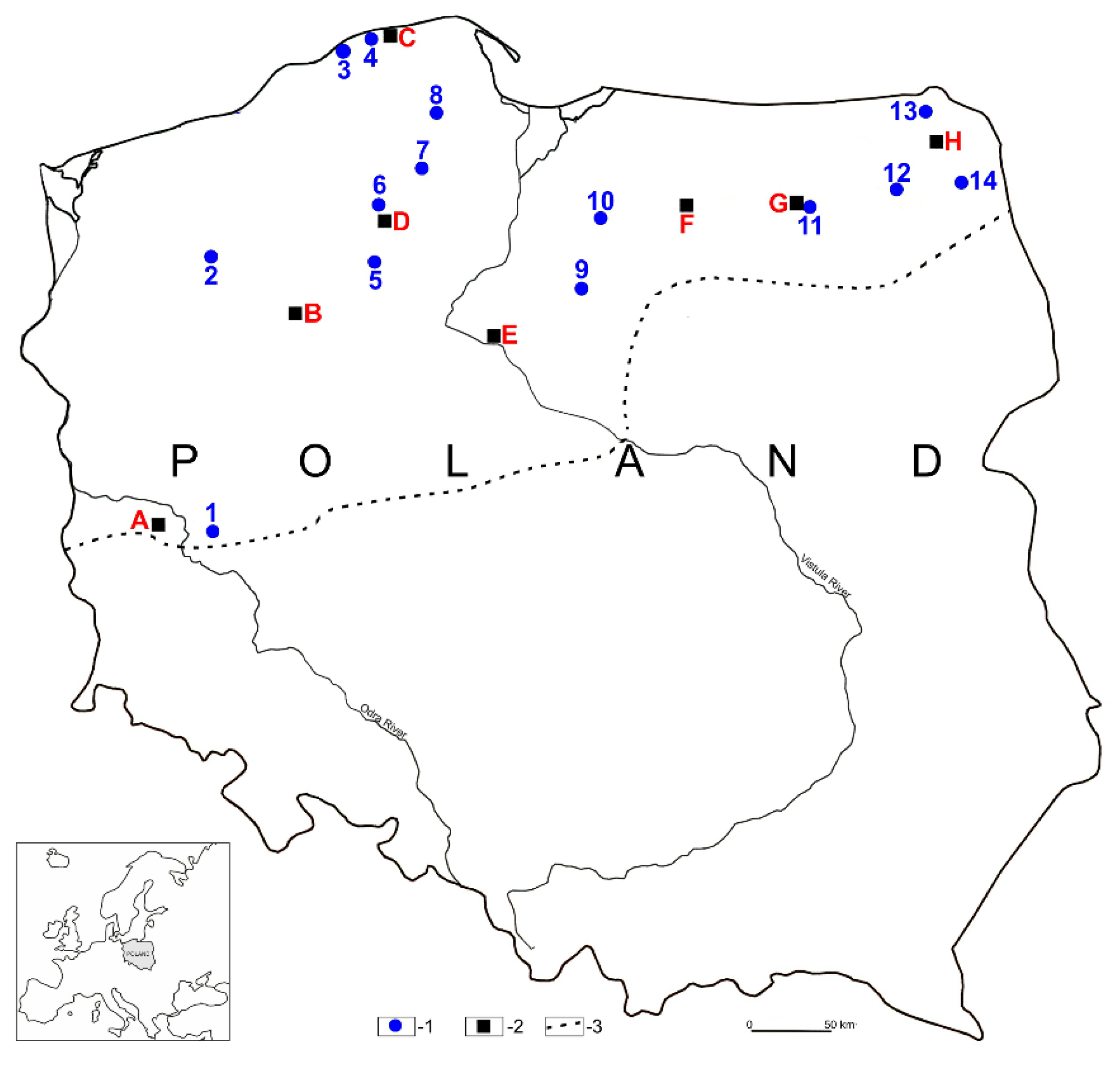
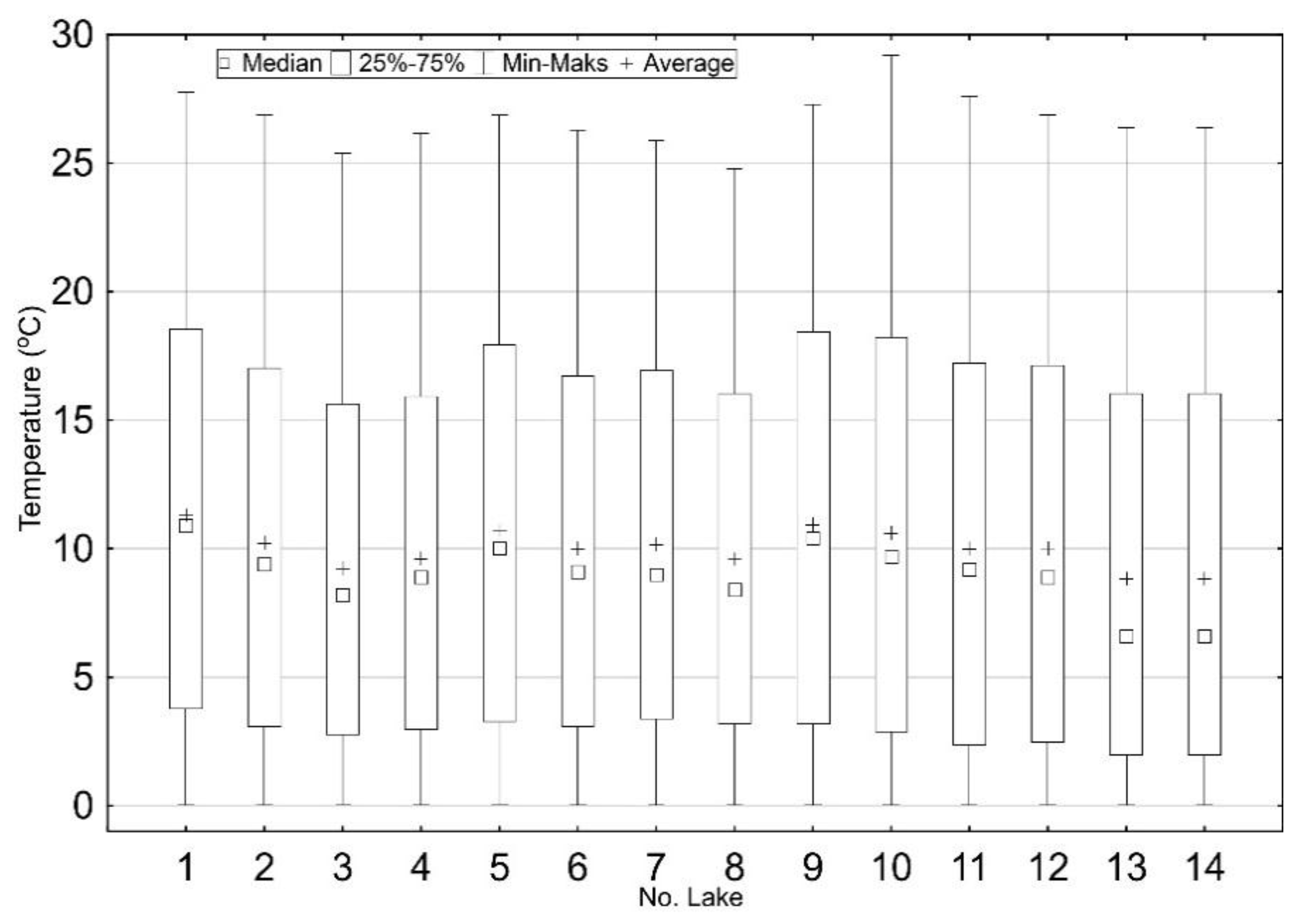
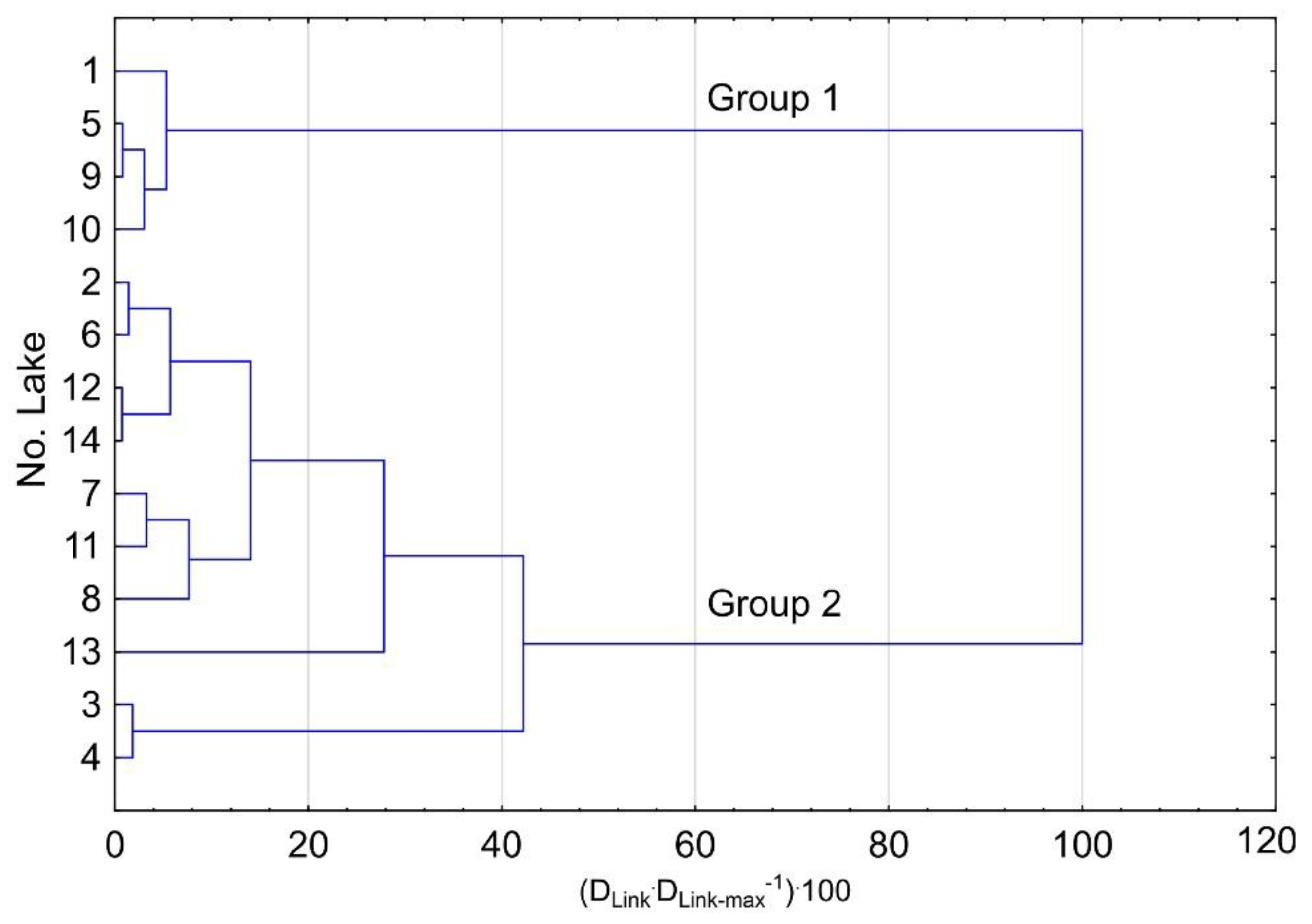
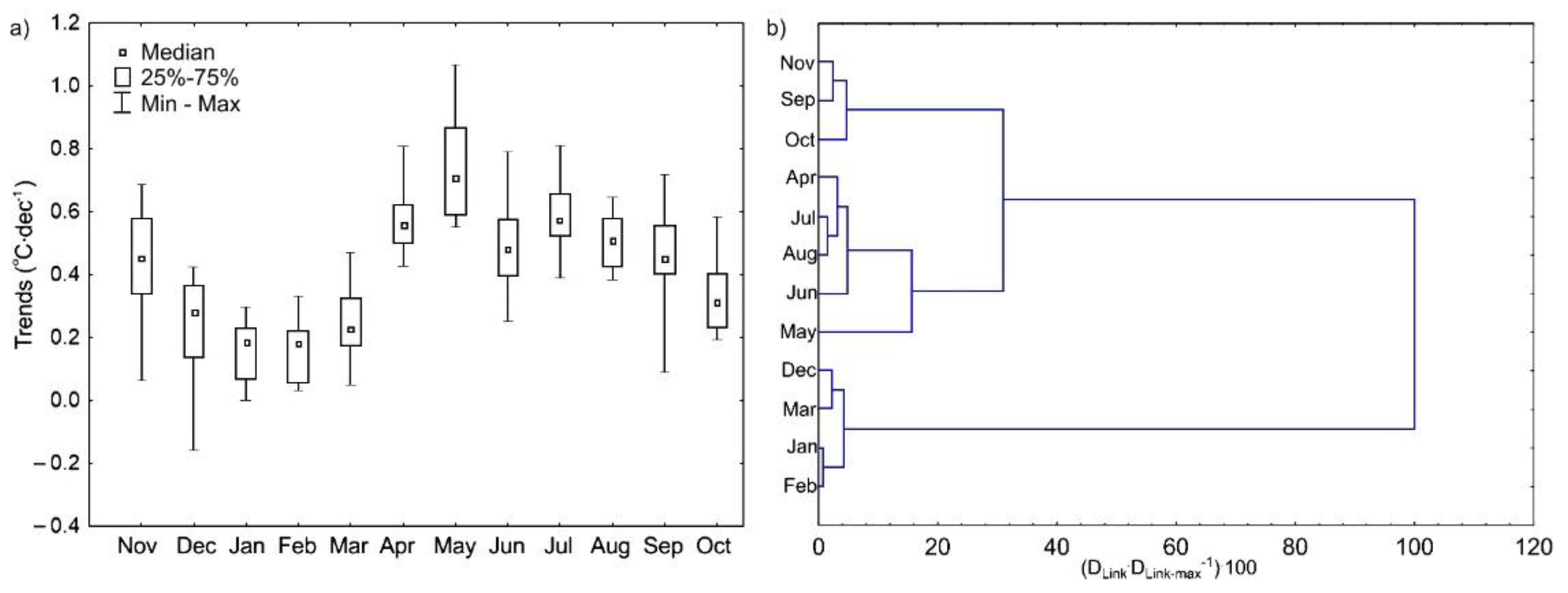
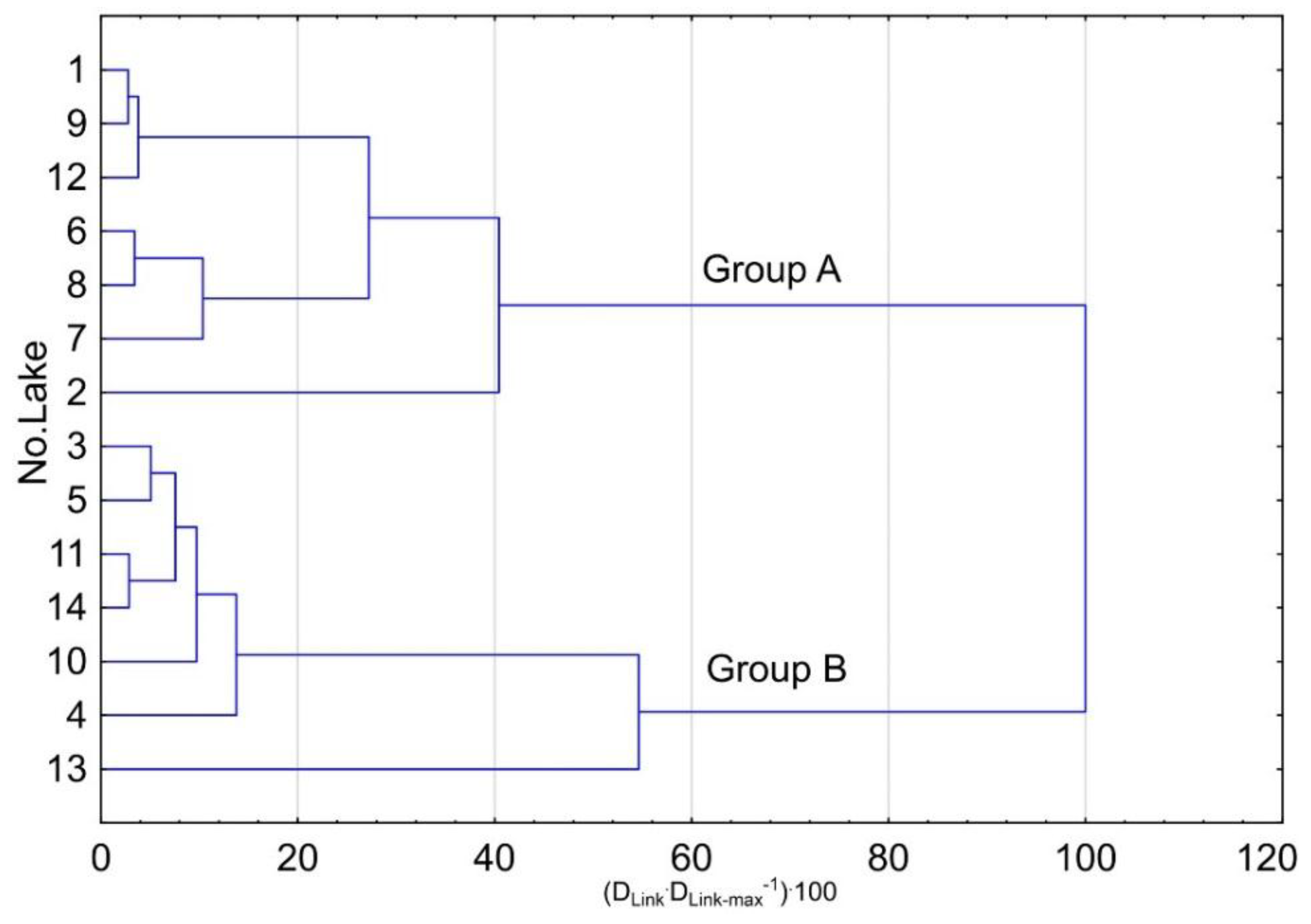

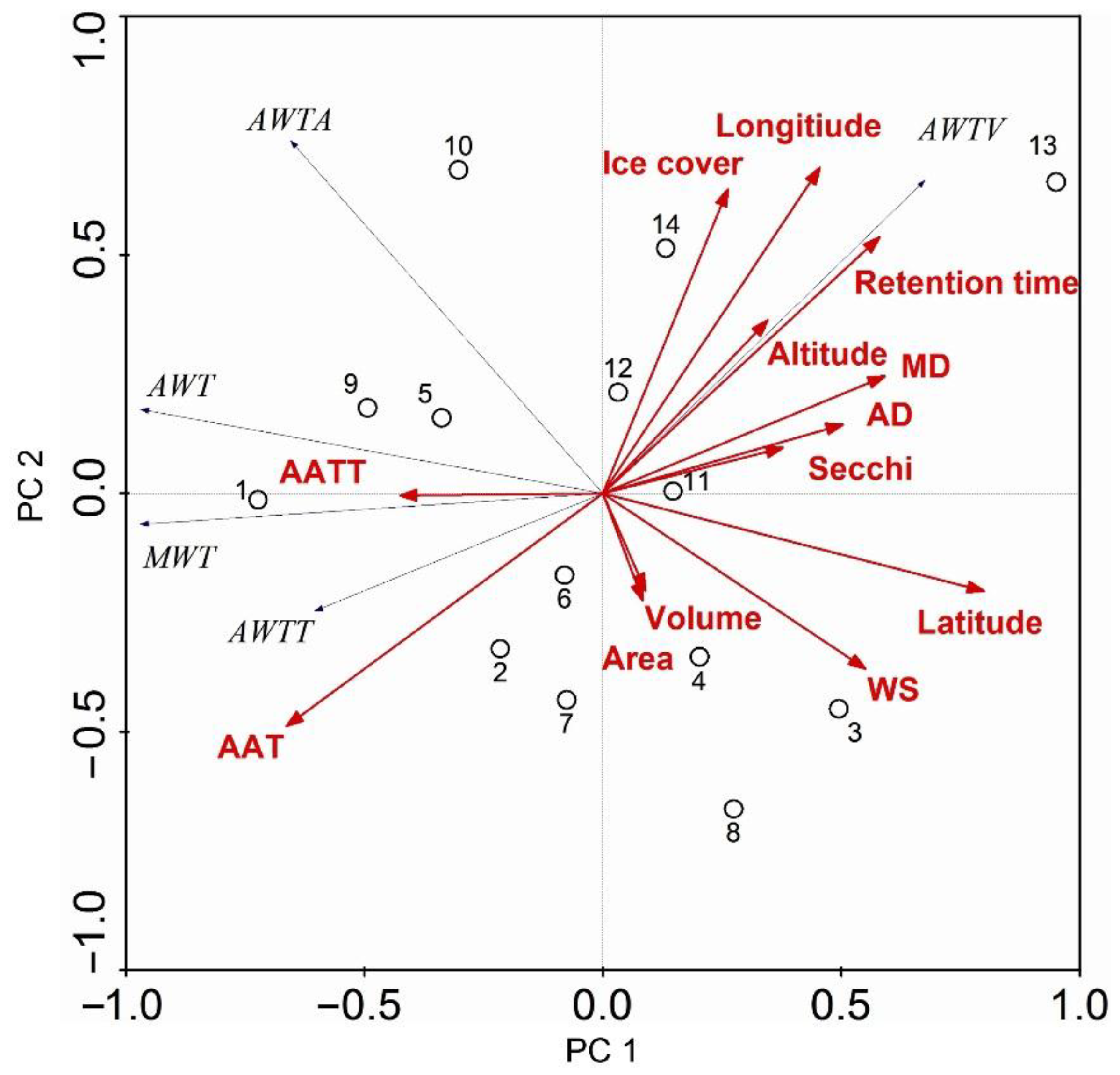
| No. | Lake | Meteorological Station | Latitude North (Lake) | Longitude East (Lake) | Depth Max [m] | Depth Mean [m] | Area [ha] | Altitude [m a.s.l.] | Transparency Secchi [m] | Average Duration of Ice Cover [days] | % Water Exchange in a Year (Retention Time) | Volume [thou. m3] | Average Wind Speed [m·s1] |
|---|---|---|---|---|---|---|---|---|---|---|---|---|---|
| 1 | Sławskie | Zielona Góra (A) | 51.89 | 16.02 | 12.3 | 5.2 | 822.5 | 56.9 | 1.1 | 55 | 1.6 | 42,664.8 | 3.2 |
| 2 | Lubie | Piła (B) | 53.45 | 15.91 | 46.2 | 11.6 | 1487.5 | 95.5 | 2.7 | 55 | 1.0 | 169,880.5 | 2.8 |
| 3 | Gardno | Łeba (C) | 54.71 | 17.39 | 2.6 | 1.3 | 2337.5 | 0.3 | 0.7 | 55 | 0.2 | 30,950.5 | 4.9 |
| 4 | Łebsko | Łeba (C) | 54.65 | 17.10 | 6.3 | 1.6 | 7020 | 0.3 | 0.6 | 55 | 0.4 | 117,521.0 | 4.9 |
| 5 | Sępoleńskie | Chojnice (D) | 53.46 | 17.51 | 10.9 | 4.8 | 157.5 | 112.8 | 1.2 | 65 | 0.6 | 7501.6 | 3.7 |
| 6 | Charzykowskie | Chojnice (D) | 53.77 | 17.50 | 30.5 | 9.8 | 1336 | 120 | 2.1 | 65 | 0.6 | 134,533.2 | 3.7 |
| 7 | Wdzydze | Chojnice (D) | 53.98 | 17.91 | 69.5 | 15.5 | 1417 | 134 | 2.9 | 75 | 1.3 | 220,800 | 3.7 |
| 8 | Raduńskie Górne | Chojnice (D) | 54.24 | 17.98 | 43 | 15.5 | 362.5 | 161.6 | 4.1 | 75 | 2.6 | 60,158.7 | 3.7 |
| 9 | Bachotek | Toruń (E) | 53.30 | 19.47 | 24.3 | 7.2 | 215 | 70.8 | 3.6 | 75 | 0.5 | 15,394.2 | 2.7 |
| 10 | Jeziorak | Olsztyn (F) | 53.72 | 19.62 | 12.9 | 4.1 | 3152.5 | 99.2 | 0.8 | 85 | 3.2 | 141,594.2 | 2.9 |
| 11 | Mikołajskie | Mikołajki (G) | 53.77 | 21.60 | 25.9 | 11.2 | 424 | 115.7 | 1.3 | 85 | 0.2 | 55,739.7 | 3.0 |
| 12 | Selmęt Wielki | Mikołajki (G) | 53.83 | 22.48 | 21.9 | 7.8 | 1207.5 | 120.7 | 1.5 | 85 | 0.3 | 9963.9 | 3.0 |
| 13 | Hańcza | Suwałki (H) | 54.27 | 22.81 | 106.1 | 38.7 | 291.5 | 227.3 | 5.2 | 85 | 12.0 | 120,364.1 | 3.8 |
| 14 | Studzieniczne | Suwałki (H) | 53.87 | 23.12 | 30.5 | 8.7 | 244 | 123.4 | 2.7 | 95 | 3.6 | 22,073.6 | 3.8 |
| No. | Lake | Nov. | Dec. | Jan. | Feb. | Mar. | Apr. | May | Jun. | Jul. | Aug. | Sep. | Oct. | Year |
|---|---|---|---|---|---|---|---|---|---|---|---|---|---|---|
| 1 | Sławskie | *** | * | * | * | *** | *** | ** | *** | *** | *** | *** | *** | |
| 2 | Lubie | *** | ** | *** | *** | *** | *** | *** | *** | *** | *** | *** | *** | *** |
| 3 | Gardno | ** | *** | ** | * | * | ** | ** | + | *** | ||||
| 4 | Łebsko | + | *** | *** | * | ** | ** | *** | *** | |||||
| 5 | Sępoleńskie | *** | * | ** | ** | ** | * | *** | *** | *** | *** | |||
| 6 | Charzykowskie | ** | ** | * | ** | ** | *** | *** | * | ** | ** | ** | * | *** |
| 7 | Wdzydze | ** | * | * | * | + | *** | *** | *** | ** | *** | *** | ** | *** |
| 8 | Raduńskie Górne | *** | ** | ** | ** | ** | *** | *** | *** | * | ** | ** | *** | |
| 9 | Bachotek | *** | ** | * | *** | + | ** | *** | *** | ** | *** | *** | *** | *** |
| 10 | Jeziorak | ** | * | ** | * | ** | *** | *** | ** | *** | ||||
| 11 | Mikołajskie | ** | * | * | + | ** | ** | * | ** | *** | ** | * | *** | |
| 12 | Selmęt Wielki | *** | *** | ** | * | * | *** | *** | ** | ** | *** | ** | ** | *** |
| 13 | Hańcza | + | + | *** | *** | *** | * | * | *** | |||||
| 14 | Studzieniczne | *** | * | * | ** | * | ** | ** | * | ** | *** | ** | * | *** |
| Meteorological Station | Nov. | Dec. | Jan. | Feb. | Mar. | Apr. | May | Jun. | Jul. | Aug. | Sep. | Oct. | Year |
|---|---|---|---|---|---|---|---|---|---|---|---|---|---|
| Zielona Góra | * | *** | ** | * | * | ** | * | *** | |||||
| Suwałki | * | *** | * | *** | ** | * | ** | ||||||
| Chojnice | * | *** | + | * | * | ** | * | *** | |||||
| Olsztyn | + | *** | * | ** | *** | * | ** | ||||||
| Piła | * | *** | * | * | * | ** | * | *** | |||||
| Mikołajki | + | *** | * | ** | ** | * | ** | ||||||
| Łeba | * | *** | * | * | * | *** | ** | ** | |||||
| Toruń | * | *** | + | * | ** | ** | * | ** |
| No. | Meteorological Station | Suwałki | Olsztyn | Chojnice | Mikołajki | Piła | Toruń | Zielona Góra | Łeba | |
|---|---|---|---|---|---|---|---|---|---|---|
| Lake | ||||||||||
| 1 | Sławskie | 0.87 | ||||||||
| 2 | Lubie | 0.75 | ||||||||
| 3 | Gardno | 0.93 | ||||||||
| 4 | Łebsko | 0.89 | ||||||||
| 5 | Sępoleńskie | 0.89 | ||||||||
| 6 | Charzykowskie | 0.85 | ||||||||
| 7 | Wdzydze | 0.88 | ||||||||
| 8 | Raduńskie Górne | 0.87 | ||||||||
| 9 | Bachotek | 0.82 | ||||||||
| 10 | Jeziorak | 0.76 | ||||||||
| 11 | Mikołajskie | 0.83 | ||||||||
| 12 | Selmęt Wielki | 0.78 | ||||||||
| 13 | Hańcza | 0.74 | ||||||||
| 14 | Studzieniczne | 0.82 | ||||||||
© 2018 by the authors. Licensee MDPI, Basel, Switzerland. This article is an open access article distributed under the terms and conditions of the Creative Commons Attribution (CC BY) license (http://creativecommons.org/licenses/by/4.0/).
Share and Cite
Ptak, M.; Sojka, M.; Choiński, A.; Nowak, B. Effect of Environmental Conditions and Morphometric Parameters on Surface Water Temperature in Polish Lakes. Water 2018, 10, 580. https://doi.org/10.3390/w10050580
Ptak M, Sojka M, Choiński A, Nowak B. Effect of Environmental Conditions and Morphometric Parameters on Surface Water Temperature in Polish Lakes. Water. 2018; 10(5):580. https://doi.org/10.3390/w10050580
Chicago/Turabian StylePtak, Mariusz, Mariusz Sojka, Adam Choiński, and Bogumił Nowak. 2018. "Effect of Environmental Conditions and Morphometric Parameters on Surface Water Temperature in Polish Lakes" Water 10, no. 5: 580. https://doi.org/10.3390/w10050580
APA StylePtak, M., Sojka, M., Choiński, A., & Nowak, B. (2018). Effect of Environmental Conditions and Morphometric Parameters on Surface Water Temperature in Polish Lakes. Water, 10(5), 580. https://doi.org/10.3390/w10050580








